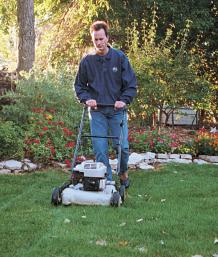
I tell my radio listeners that autumn is the best time of the year to work on their turf. That’s when cool temperatures return, the soil is still warm, rainfall is steady, and the competition for nutrients from weeds is relatively low. These conditions not only bolster turf growth, but also help heal the wounds lawns may have suffered during a hot, dry summer. Other problems that affect turf health, like soil compaction and the build-up of thatch, are also best remedied in fall. A maintenance program that includes aerating, fertilizing, removing thatch, and spraying weeds in the fall will ensure that your lawn looks good come spring.
Create pockets for air, water, and nutrients
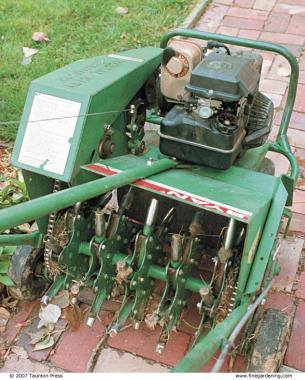
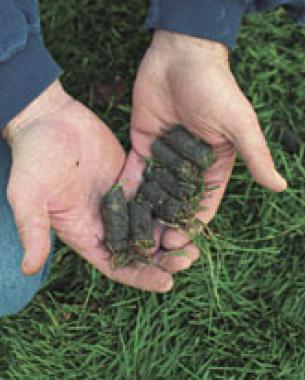
Foot traffic compacts the soil underneath turf and restricts the flow of water and nutrients to turf roots. The best way to open up compacted soil is to create entry points for air, water, and fertilizer with a core aerator. Similar in size to a lawn mower, a core aerator has a series of tines mounted onto a rotating drum. Since this machine costs between $5,000 and $10,000 to buy, I rent one instead for $50 a day.
There are two types of aerating tines, and turf professionals are still debating which works best. Current opinion is that hollow tines, which remove plugs of turf, roots, and soil, are best used to aerate compacted clay soils. Solid, spikelike tines that poke holes in the turf but don’t remove plugs are best used to aerate sandy soils.
I usually aerate my lawn soon after Labor Day. My soil is heavy clay, so I use a hollow-tined aerator. I leave the extracted plugs of grass and soil on the lawn for a few days to dry before I pulverize the plugs the next time I mow. The chopped soil will filter through the turf and settle on top of any thatch that has accumulated. This is beneficial since the microorganisms in the soil help to break down the thatch. There’s no doubt that aeration is a destructive process, as each plug contains viable roots and turf, but done once a year, it is more beneficial than detrimental.
Apply a fertilizer to promote strong roots
In fall, turf grass channels its energy into root growth rather than stem growth, so any nutrients applied then help grass plants build strong root systems. Although many gardeners believe nitrogen promotes only stem growth, nitrogen applied in fall helps root growth as well. Since turf roots continue to grow until the ground freezes, sometime between Thanksgiving and Christmas in my area, I make the first of my two fall applications around Labor Day, and the second a couple of months later.
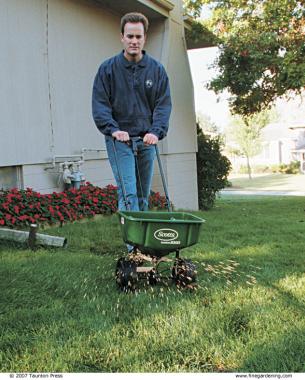
Although I fertilize my lawn year-round with a slow-release fertilizer with the N-P-K ratio of 28-3-6, research studies have shown that the last application in the fall is the most crucial. Nutrients applied then are stored in the turf’s crowns, rhizomes, stolons, and roots and utilized when favorable growing conditions resume in spring. I like to time this application as my turf starts to go dormant and harden off for the winter, which, in my area, is usually around Halloween. The amount of fertilizer I apply depends on the time of year I’m applying it.
How much fertilizer does a lawn need?
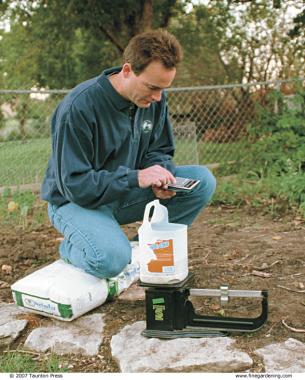
The two questions I am most often asked about lawn fertilizer application are how much fertilizer to apply and how often to apply it. How often is an easy question to answer: I fertilize on or around Tax Day (April 15), Memorial Day, Labor Day, and Halloween.
Determining how much fertilizer to spread is a little more complicated. To calculate the exact amount I need to buy, I have to know three numbers: the amount of nitrogen I need to spread per 1,000 square feet, the total square footage of my lawn, and the percentage of nitrogen contained in the fertilizer I’m planning to spread.
The amount of nitrogen I spread depends on the time of year. There is a general guideline I use, based on pounds of nitrogen applied per 1,000 square feet of lawn: ½ pound on Tax Day, 1 pound on Memorial Day and Labor Day, and 1½ pounds at Halloween.
Since I consider the Halloween application to be the most important, I’ll use that as an example. My lawn measures 5,000 square feet, and at that time I want to spread 1½ pounds of nitrogen per 1,000 square feet of my lawn. The fertilizer I’m spreading has an NPK ratio of 28-3-6, or 28 percent nitrogen. To determine the amount of 28-3-6 fertilizer I need to buy for my lawn, I plug those numbers into the following formula:
(Pounds per 1,000 sq. ft. ÷ N%) × total square footage of lawn/1,000 = amount of fertilizer
Example: (1.5 ÷ 0.28) × (5,000 ÷ 1,000) = 27 pounds of 28-3-6 fertilizer
The various sources of nitrogen affect growth rate and greenness of turf differently, so I check a fertilizer’s label for the nitrogen source before buying it. I look for fertilizers whose nitrogen is derived from sulfur-coated urea, water-insoluble nitrogen (WIN), or ureaformaldehyde. Fast-release products such as ammonium nitrate, urea, or ammonium sulfate leach out of the soil quickly. Organic sources of nitrogen like feather meal, bone meal, and animal manures are best used for the Labor Day application when warmer soil temperatures can more easily break them down to release the nitrogen.
Remove thatch with a power rake
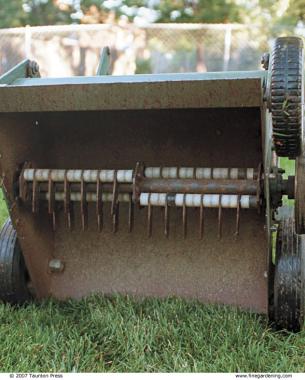
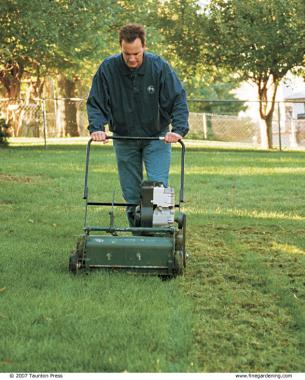
A natural consequence of healthy turf growth is thatch, which is the layer of dead and dying plant crowns, protective rhizome sheaths, and similar plant tissues found between the soil line and the bottom of the turf blades. (Contrary to popular belief, thatch is not made up of grass and leaf clippings, which are 85 percent water and readily break down once cut with a mower.) An excessive amount of thatch is detrimental to the health of your lawn. If grass grows too thick, its roots tend to grow into the thatch instead of into the soil. Since thatch doesn’t hold nutrients and water, it cannot provide the nutrients and moisture turf needs.
When the thatch in my lawn measures more than 1/2 to 5/8 inch thick, I use a power rake to remove it. Similar in size to a lawn mower, a power rake has a series of vertical blades that rip out thatch when rolled over a lawn. I suggest that you hire several teenagers to help with this job, since the machine is heavy and there’s a lot of thatch to rake up afterward. I rent one for $50 a day.
Like aerating, power raking is disruptive, so I do it soon after Labor Day to give turf roots enough time to recover before winter arrives. Manual raking can also be effective at removing thatch, but it is a labor-intensive job and is only effective if you use a specially designed thatching rake. Unlike aerating, removing the thatch may not be an annual project. It all depends on how quickly thatch builds up.
In fall, mow lower and less often
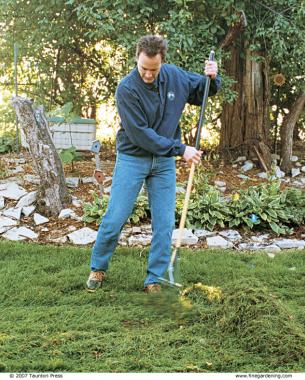
In summer, I raise the level of my mower blade because taller grass blades create a canopy that shades crowns from sun and encourages deep root growth. In fall, I lower the blade level and cut my grass shorter because shorter blades allow the grass to concentrate on root growth. I mow Kentucky bluegrass, perennial ryegrass, and fine leaf fescue lawns at 3 inches during the summer and at 2 inches in fall, whereas I mow turf-type tall fescue at 3½ to 4 inches in summer and 2½ to 3 inches in fall. Also, as fall progresses and my lawn starts to go dormant, I mow less often.
Cutting your grass too short is one of the worst things you can do to your lawn. When mowing, I follow the “one-third rule,” no matter what season it is. This rule states that only one-third of the vegetation (from the soil line to the leaf tips) should be removed at each mowing. For example, if a 2-inch height of cut is desired, I mow when the turf growth reaches 3 inches. I use my ruler to determine when to mow.
I don’t bag my clippings. If they’re not too long, mulched grass clippings filter back into the turf canopy without detracting from the beauty of the lawn or increasing the thatch layer. Even if you use a side-discharge mower instead of a mulching mower, cuttings should not detract from a lawn’s appearance as long you follow the one-third rule.
Reseed bare spots after aerating and thatching
Seed to soil contact is essential when sowing grass seed, so right after you’ve aerated and raked is a good time to seed any bare spots in your lawn. When seeding, I like to sow the same kind of seed as the grass that’s already growing. If a lawn is predominantly Kentucky bluegrass, sowing the seed of improved cultivars of the same type of grass will add to the genetic diversity of the lawn while increasing its disease resistance. Introducing another species tends to produce a noticeably different texture. The exception is fine fescue, which is often added to lawns to increase its shade tolerance.
Fall is also the best time to reseed a sparsely growing lawn. The amount of seed I spread depends on the type of grass I’m dealing with. I sow Kentucky bluegrass and perennial ryegrass at a rate of 1 to 2 pounds per 1,000 square feet, fine fescue at 2 to 3 pounds per 1,000 square feet, and turf-type tall fescue at 4 to 5 pounds per 1,000 square feet. I then water the lawn lightly and frequently.
Control diseases and weeds
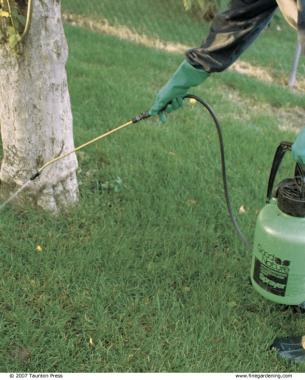
The cool temperatures and moist conditions of fall can encourage the development of several fungal diseases, including leaf spot, stripe smut, rust, and powdery mildew. To defend against these problems, I prune my trees and shrubs to increase air circulation over my lawn, and water it only in the morning hours. The best defense against disease is to grow a thick healthy turf that naturally resists these fungal infections.
While broadleaf weeds such as dandelion, plantain, and white clover are gluttons for soil nutrients during the entire growing season, they are especially busy in fall, collecting them up for winter storage. The good thing is that any herbicide applied at this time will be as vigorously collected. For a lawn full of weeds, I recommend a “weed and feed” type of product like Scotts Turf Builder Plus 2. But for lawns that have only a few weeds here and there, I would recommend spot-spraying them with a broad-spectrum herbicide such as Weed-B-Gon or Trimec. To do this, I use a 1-gallon, pressurized tank sprayer that keeps the spray low to the ground to protect my valuable ornamentals from drift. As always, be sure to read and follow the label directions when using any herbicide.
A lawn can be an integral part of a garden. Whether it covers an expansive area or is just a small patch, your turf grass deserves the same kind of pampering you give your perennials, annuals, shrubs, and trees. With a few hours of work in fall, you can lay the groundwork for a lush green carpet that will make your entire garden look better come spring.



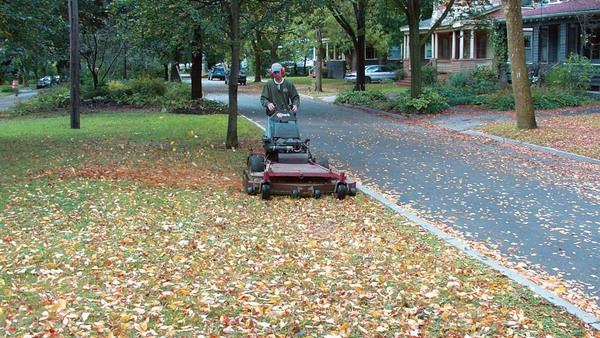
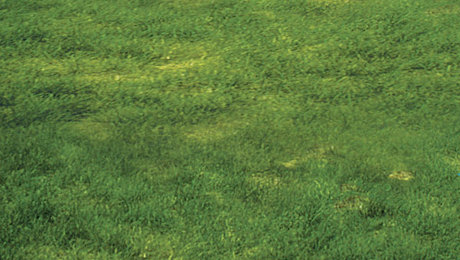












Comments
No matter what the season, it's true that maintenance will always take part in the health of your lawn. this is why it is best to choose first the best type of turf. Check this link for more info http://goo.gl/0dH0qH
Great article John, and it's good to see someone promoting autumn as a good time to work on their turf. A lot of people in my area just call it good for the season once October rolls around. Fall and spring are the best time of the year to aerate your lawn though, and I've had a lot of success with fall aeration. Here's an article I just wrote about lawn aeration (benefits, when to do it, etc) that I think readers might enjoy.
http://goo.gl/ugLmLK
Nice to read. So useful and informative tips. Many thanks for the autumn turf tips these autumn tips really beneficial to my turf thank you. Find more info Tooled Up discount codes
Log in or create an account to post a comment.
Sign up Log in